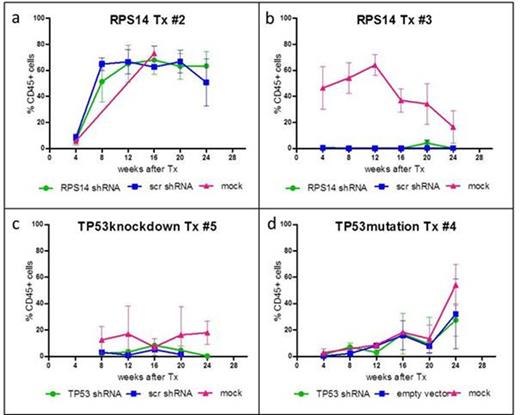Abstract
Chromosomal instability (CIN) is one of the characteristics of myelodysplastic syndromes (MDS) and plays an important role in diagnosis and prognosis as well as in disease progression. Candidate genes are known, but their role in induction of CIN has never been shown due to difficulties in culturing MDS cells long-term, showing the urgent need to have a model to study the fate of cells with typical MDS abnormalities with regard to CIN. The aim of our approach was to establish a xenograft transplantation model, transplanting human hematopoietic stem cells (HSC) with different independent lentivirally-mediated MDS-related modifications into immunodeficient mice. The establishment of appropriate xenograft mouse models is increasing worldwide. Thus, experiences should be shared to contribute towards minimizing loss of mice in this process.
HSCs were intrafemorally transplanted into immunodeficient NSG and/or NSGS mice. Here, we chose 3 different modifications that, in part, were to be combined in later experiments. 1) RPS14-haploinsufficient HSCs via shRNA knockdown, 2) TP53-deficient HSCs via shRNA knockdown and 3) HSCs, with different lentivirally introduced TP53 hotspot mutations (R248W, R175H, R273H, R249S).
We achieved engraftment with HSC in these mice (Figure 1). Cytogenetic analyses of the bone marrow showed human cells with normal karyotypes. However, we were not able to induce chromosomal instability into the cells. NSGS mice transplanted with HSCs carrying a TP53 mutation developed anemia but no histopathological signs of myelodysplasia. In all experiments with NSG mice, mainly control cells as well as the untransduced GFP-negative (GFP-) cells engrafted, not allowing observation of the modified HSCs over a long period. In NSGS mice, the engraftment rate was higher, but mice developed graft-versus-host disease (GVHD).
In summary, engraftment of HSC cells in NSG and NSGS is very promising and could be used to analyze the induction of chromosomal instability. However, the analysis of transduced HSCs with different vectors is limited as yet and further transplantations with the co-transplantation of mesenchymal stroma cells and the inhibition of GVHD are required to improve this model.
Selected examples from the different transplantation experiments representing engraftment success to some extent. Depicted is the median percentage of CD45+ cells equaling engraftment of human cells in target vector- and control vector-transduced cells as well as untransduced mock cells.
No relevant conflicts of interest to declare.
Author notes
Asterisk with author names denotes non-ASH members.


This feature is available to Subscribers Only
Sign In or Create an Account Close Modal